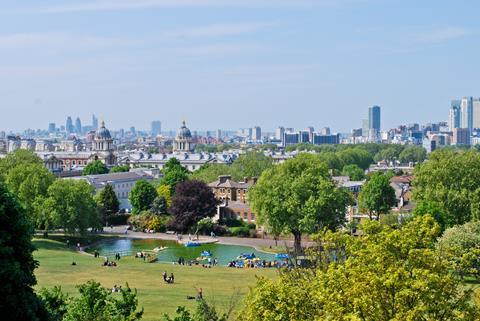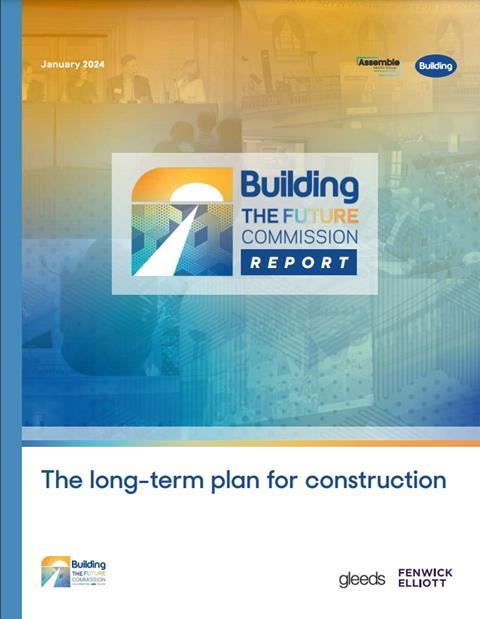After a year of consultation and careful consideration, the Building the Future Commission has published its final report. In this chapter, Ben Flatman explores ways in which we might close the gap between good development and the development we too often deliver

A long way to go
The standard of urban design and the thought given to both environmental and social sustainability in the UK is well below where it should be. As Jo Wright of Perkins+Will told us regarding net zero: “The built environment is not doing its bit. We are not doing well enough – other sectors are doing better.” We continue to build new housing, as well as commercial and retail developments, that do not deliver in terms of good-quality urban design or community-building. New residential development on the edge of existing towns too often remains car-dependant, poorly integrated into existing pedestrian routes, and lacking in basic amenities.

>> Download the full commission report: The long-term plan for construction
There remains a huge gap between good development and the type of development we actually deliver. Part of the problem lies in the way that design and planning professionals are trained – in silos that focus either on individual buildings, or on strategic and economic plans, but with very few people properly trained to deliver high-quality urban design.
Language and people matter
The language we use to describe the built environment is constantly changing, as our understanding of the interaction between people, practice and place evolves. Terms such as “placemaking” and “masterplanning” are being questioned by many leading professionals in the industry because of the way that they imply a blank canvas and top-down solutions.
In our discussions, David Rudlin of BDP and Anna Mansfield of Publica highlighted how the use of the word “placemaking” and attitudes around it need to be reassessed as attitudes change. In reality, no development exists in a vacuum, and there is always something – including a community – in a place that gives it a history and context.
Old assumptions about top-down urban design and development solutions no longer hold true. Increasingly, developers and consultants recognise the need to engage with existing communities, and the value – economic and social – in celebrating and enhancing what makes each place special.
Engage fully with communities
Community engagement has been part of planning best practice for decades, but has also often been seen by a sceptical public as whitewashing of private sector interests. The cynicism that surrounds planning and development is not unfounded as, too often, planners and developers have pushed through projects that do not necessarily serve a local community’s best interests.
The industry needs to engage with communities at the earliest opportunity. Schemes like Human Nature’s Phoenix project in central Lewes have grown out of grassroots community dissatisfaction with “more of the same” conventional development, but have been taken on by private sector entrepreneurs who see the opportunity to harness people power in the delivery of good-quality places that also turn a profit.
Selina Mason, head of masterplanning at Lendlease, highlighted to the commission how people are central to successful development and urban design, and that by placing communities at the centre of consultation and design processes, developers can achieve both social and economic success.
Co-design and genuine collaboration with existing communities can help build in stakeholder engagement and support. In Lewes this has led to a scheme that is less car dependant and actually of higher density – outcomes that potentially benefit both investors and local people.
OTHER CHAPTERS FROM THE REPORT
>> Also read: Building The Future Commission: Powering down the road to net-zero
>> Also read: Building The Future Commission: Planning to solve the housing crisis
>> Also read: Building The Future Commission: This is how we make our buildings safer
>> Also read: Building The Future Commission: Time to prepare for the next digital revolution
>> Also read: Building The Future Commission: Attracting, engaging and retaining the next generation
>> Also read: Building The Future Commmission: Take a long-term view to give UK the infrastructure it needs
Prioritise young people
Too often young people are left to the last stage of a project, with playgrounds and spaces for youths treated as an afterthought. Prioritising the needs of young people – whether that is children, teenagers or young adults – should be baked into the industry. At the moment young people’s health and wellbeing are not prioritised enough in the built environment and the knock-on effects in terms of poor life achievement and mental health issues are mounting.
Anna Mansfield of Publica highlighted how retail spaces and department stores have often been of great importance to young people, and also how developers, architects and planners need to put much greater emphasis on creating spaces for young people in their developments.
The prioritisation of young people needs to run through the thinking around urban design and the provision of facilities, so that they can feel safe and comfortable. We should not forget that retail spaces have often provided such spaces, but we also need to prioritise new, non-privately owned safe spaces for young people to meet and congregate.
Deliver healthy cities
Getting people active by providing opportunities for active travel and sport is seen as more important than ever, especially as the UK recovers from the pandemic and in the light of a growing epidemic of obesity and poor health.
Urban design, transport strategies and new development all have critical roles to play in encouraging people to be more active. Exercise is closely associated with improved mental and physical health outcomes.
By discouraging car use and providing good-quality public transport and last-mile transport options (such as cycling and e-scooters), the culture can be shifted towards walking and cycling, rather than driving.
This requires a network of mobility hubs close to existing transport hubs, and new ways of making our existing infrastructure more appealing. In Manchester, this could soon include reimagining stations as community hubs, with health facilities and “maker spaces” to share skills.
Work with and not against place, and reuse where possible
In Fleetwood, Lancashire, The King’s Foundation is working with the local community to turn a disused hospital into a new community hub, with a cafe, a higher education centre and new health facilities. The approach is based on the principle that very often the best way to revive pride and economic life in a left-behind place is to celebrate and repair what is already there.
Very often, even our most neglected and deprived towns have historic buildings that, if properly cared for, can help reinforce an existing sense of place and rekindle a sense of civic pride among local people.
Companies such as Capital & Centric in Manchester have shown that even unloved 1960s and 1970s buildings can be brought back to life and transformed into vehicles for economic prosperity.
Creative reuse of existing buildings is where the sustainability and conservation agendas intersect, and has the potential to re-energise communities across the UK.

Properly resource the planning system
Since 2010 there have been massive cuts to the English planning system, with local authorities struggling to resource planning departments. The knock-on effects have included delays in revising local plans and deciding planning applications, and also a reduction in the urban design skills needed to deliver high-quality places.
In an interview for the commission, David Rudlin, head of urban design at BDP, pointed out that proper resourcing is critical to ensuring local authorities have the skills they need.
By properly resourcing local authority planning services – and possibly ringfencing funding – the system would be given the chance to recover and to start delivering high-quality places at pace. A 2019 report estimated that an increase of £422m a year would enable the English planning system to address current shortfalls and deliver a service “sufficient to support a regular process of developing evidence for and updating local plans, as well as for rich community participation in the process”.
Design codes, street votes and gentle density
Historically cities have grown more dense over time, as existing low-rise structures are replaced by new development at greater densities. This process is no longer occurring in many built-up areas, because of the price of property and the way that the planning system often defaults to protecting existing neighbourhood characteristics – even where they are of poor quality and no architectural value.
The planning system arguably requires significant reform (see the chapter on housing and planning). In the meantime, there are new tools that could help improve urban design quality and deliver densification of existing built-up areas without building on green belt.
Design codes help local communities set standards for development in their areas that should prevent poor-quality and unpopular development. Street votes, enabling very localised groups to voluntarily choose to identify their area for redevelopment at greater densities, could help counter nimbyism by allowing existing property owners to achieve significant uplift in their property values.
Recommendations
1. Engage fully with communities: The industry needs to engage with communities at the earliest opportunity. Co-design and genuine collaboration with existing communities can help build in stakeholder engagement and support.
2. Prioritise young people: Too often young people are left to the last stage of a project, with playgrounds and spaces for youths treated as an afterthought. Prioritising the needs of young people – whether that is children, teenagers or young adults – should be baked into the industry.
3. Deliver healthy cities: Getting people active by providing opportunities for active travel and sport is seen as more important than ever, especially as the UK recovers from the pandemic and in light of the growing epidemic of obesity and poor health. Urban design, transport strategies and new development all have critical roles to play in encouraging people to be more active.
4. Work with and not against place, and reuse where possible: Very often, even our most neglected and deprived towns have historic buildings that, if properly cared for, can help reinforce an existing sense of place and rekindle a sense of civic pride among local people. Creative reuse of existing buildings is where the sustainability and conservation agendas intersect, and has the potential to re-energise communities across the UK.
4. Properly resource the planning system: Since 2010 there have been massive cuts to the English planning system, with local authorities struggling to resource planning departments. By properly resourcing local authority planning services – and possibly ringfencing funding – the system would be given the chance to recover and to start delivering high-quality places at pace.
5. Design codes, street votes and gentle density: Historically cities have grown more dense over time, as existing low- rise structures are replaced by new development at greater densities. Design codes and street votes could help unblock nimbyism by allowing local communities to enable growth that works for them.
Download the full report below




























No comments yet